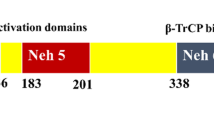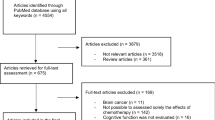Abstract
Chemotherapy-induced cognitive impairment (CICI) has been observed in a large fraction of cancer survivors. Although many of the chemotherapeutic drugs do not cross the blood–brain barrier, following treatment, the structure and function of the brain are altered and cognitive dysfunction occurs in a significant number of cancer survivors. The means by which CICI occurs is becoming better understood, but there still remain unsolved questions of the mechanisms involved. The hypotheses to explain CICI are numerous. More than 50% of FDA-approved cancer chemotherapy agents are associated with reactive oxygen species (ROS) that lead to oxidative stress and activate a myriad of pathways as well as inhibit pathways necessary for proper brain function. Oxidative stress triggers the activation of different proteins, one in particular is tumor necrosis factor alpha (TNFα). Following treatment with various chemotherapy agents, this pro-inflammatory cytokine binds to its receptors at the blood–brain barrier and translocates to the parenchyma via receptor-mediated endocytosis. Once in brain, TNFα initiates pathways that may eventually lead to neuronal death and ultimately cognitive impairment. TNFα activation of the c-jun N-terminal kinases (JNK) and Janus kinase-signal transducer and activator of transcription (JAK/STAT) pathways may contribute to both memory decline and loss of higher executive functions reported in patients after chemotherapy treatment. Chemotherapy also affects the brain’s antioxidant capacity, allowing for accumulation of ROS. This review expands on these topics to provide insights into the possible mechanisms by which the intersection of oxidative stress and TNFΑ are involved in chemotherapy-induced cognitive impairment.


Similar content being viewed by others
Availability of data and material
Not applicable for this review paper.
Code availability
Not applicable for this review paper.
References
Orchard TS et al (2017) Clearing the fog: a review of the effects of dietary omega-3 fatty acids and added sugars on chemotherapy-induced cognitive deficits. Breast Cancer Res Treat 161(3):391–398
Jean-Pierre P, Johnson-Greene D, Burish TG (2014) Neuropsychological care and rehabilitation of cancer patients with chemobrain: strategies for evaluation and intervention development. Support Care Cancer 22(8):2251–2260
Mounier NM et al (2020) Chemotherapy-induced cognitive impairment (CICI): An overview of etiology and pathogenesis. Life Sci 258:118071
Boykoff N, Moieni M, Subramanian SK (2009) Confronting chemobrain: an in-depth look at survivors’ reports of impact on work, social networks, and health care response. J Cancer Surviv 3(4):223–232
McDonald BC et al (2010) Gray matter reduction associated with systemic chemotherapy for breast cancer: a prospective MRI study. Breast Cancer Res Treat 123(3):819–828
Janelsins MC et al (2017) Cognitive complaints in survivors of breast cancer after chemotherapy compared with age-matched controls: an analysis from a nationwide, multicenter Prospective Longitudinal Study. J Clin Oncol 35(5):506–514
Ahles TA et al (2008) Cognitive function in breast cancer patients prior to adjuvant treatment. Breast Cancer Res Treat 110(1):143–152
Cheung YT et al (2013) Cytokines as mediators of chemotherapy-associated cognitive changes: current evidence, limitations and directions for future research. PLoS One 8(12):e81234
Barry RL et al (2018) In vivo neuroimaging and behavioral correlates in a rat model of chemotherapy-induced cognitive dysfunction. Brain Imaging Behav 12(1):87–95
Keeney JTR et al (2018) Doxorubicin-induced elevated oxidative stress and neurochemical alterations in brain and cognitive decline: protection by MESNA and insights into mechanisms of chemotherapy-induced cognitive impairment (“chemobrain”). Oncotarget 9(54):30324–30339
Das A et al (2020) An overview on chemotherapy-induced cognitive impairment and potential role of antidepressants. Curr Neuropharmacol 18(9):838–851
Seigers R et al (2016) Neurobiological changes by cytotoxic agents in mice. Behav Brain Res 299:19–26
Ahles TA, Saykin AJ (2007) Candidate mechanisms for chemotherapy-induced cognitive changes. Nat Rev Cancer 7(3):192–201
Pyter LM et al (2017) Novel rodent model of breast cancer survival with persistent anxiety-like behavior and inflammation. Behav Brain Res 330:108–117
Nguyen LD, Ehrlich BE (2020) Cellular mechanisms and treatments for chemobrain: insight from aging and neurodegenerative diseases. EMBO Mol Med 12(6):12075
Ren X, St Clair DK, Butterfield DA (2017) Dysregulation of cytokine mediated chemotherapy induced cognitive impairment. Pharmacol Res 117:267–273
Deprez S et al (2012) Longitudinal assessment of chemotherapy-induced structural changes in cerebral white matter and its correlation with impaired cognitive functioning. J Clin Oncol 30(3):274–281
McDonald BC et al (2013) Frontal gray matter reduction after breast cancer chemotherapy and association with executive symptoms: a replication and extension study. Brain Behav Immun 30(Suppl):S117–S125
Hanisch UK, Kettenmann H (2007) Microglia: active sensor and versatile effector cells in the normal and pathologic brain. Nat Neurosci 10(11):1387–1394
Seruga B et al (2008) Cytokines and their relationship to the symptoms and outcome of cancer. Nat Rev Cancer 8(11):887–899
Wang XM et al (2015) Chemobrain: a critical review and causal hypothesis of link between cytokines and epigenetic reprogramming associated with chemotherapy. Cytokine 72(1):86–96
Wardill HR et al (2016) Cytokine-mediated blood brain barrier disruption as a conduit for cancer/chemotherapy-associated neurotoxicity and cognitive dysfunction. Int J Cancer 139(12):2635–2645
Schrepf A, Lutgendorf SK, Pyter LM (2015) Pre-treatment effects of peripheral tumors on brain and behavior: neuroinflammatory mechanisms in humans and rodents. Brain Behav Immun 49:1–17
Terrando N et al (2010) Tumor necrosis factor-alpha triggers a cytokine cascade yielding postoperative cognitive decline. Proc Natl Acad Sci USA 107(47):20518–20522
Zhao J et al (2020) Changes in plasma IL-1beta, TNF-alpha and IL-4 levels are involved in chemotherapy-related cognitive impairment in early-stage breast cancer patients. Am J Transl Res 12(6):3046–3056
Ganz PA et al (2013) Does tumor necrosis factor-alpha (TNF-alpha) play a role in post-chemotherapy cerebral dysfunction? Brain Behav Immun 30(Suppl):S99-108
Jenkins V et al (2016) A feasibility study exploring the role of pre-operative assessment when examining the mechanism of “chemo-brain” in breast cancer patients. Springerplus 5:390
Tian T, Wang M, Ma D (2014) TNF-alpha, a good or bad factor in hematological diseases? Stem Cell Investig 1:12
Laumet G et al (2020) Interleukin-10 resolves pain hypersensitivity induced by cisplatin by reversing sensory neuron hyperexcitability. Pain 161(10):2344–2352
Aluise CD et al (2011) 2-Mercaptoethane sulfonate prevents doxorubicin-induced plasma protein oxidation and TNF-alpha release: implications for the reactive oxygen species-mediated mechanisms of chemobrain. Free Radic Biol Med 50(11):1630–1638
Butterfield DA (2014) The 2013 SFRBM discovery award: selected discoveries from the butterfield laboratory of oxidative stress and its sequela in brain in cognitive disorders exemplified by Alzheimer disease and chemotherapy induced cognitive impairment. Free Radic Biol Med 74:157–174
Keeney JT et al (2015) Superoxide induces protein oxidation in plasma and TNF-alpha elevation in macrophage culture: Insights into mechanisms of neurotoxicity following doxorubicin chemotherapy. Cancer Lett 367(2):157–161
Joshi G et al (2007) Glutathione elevation by gamma-glutamyl cysteine ethyl ester as a potential therapeutic strategy for preventing oxidative stress in brain mediated by in vivo administration of adriamycin: Implication for chemobrain. J Neurosci Res 85(3):497–503
Tangpong J et al (2006) Adriamycin-induced, TNF-alpha-mediated central nervous system toxicity. Neurobiol Dis 23(1):127–139
Joshi G et al (2010) Alterations in brain antioxidant enzymes and redox proteomic identification of oxidized brain proteins induced by the anti-cancer drug adriamycin: implications for oxidative stress-mediated chemobrain. Neuroscience 166(3):796–807
Ongnok B, Chattipakorn N, Chattipakorn SC (2020) Doxorubicin and cisplatin induced cognitive impairment: the possible mechanisms and interventions. Exp Neurol 324:113118
Wahdan SA et al (2020) Abrogating doxorubicin-induced chemobrain by immunomodulators IFN-beta 1a or infliximab: Insights to neuroimmune mechanistic hallmarks. Neurochem Int 138:104777
Owen KL, Brockwell NK, Parker BS (2019) JAK-STAT Signaling: A Double-Edged Sword of Immune Regulation and Cancer Progression. Cancers (Basel) 11(12):2002
Seif F et al (2017) The role of JAK-STAT signaling pathway and its regulators in the fate of T helper cells. Cell Commun Signal 15(1):23
Simon AR et al (1998) Activation of the JAK-STAT pathway by reactive oxygen species. Am J Physiol 275(6):C1640–C1652
Lee C et al (2013) TNF alpha mediated IL-6 secretion is regulated by JAK/STAT pathway but not by MEK phosphorylation and AKT phosphorylation in U266 multiple myeloma cells. Biomed Res Int 2013:580135
Guo D et al (1998) Induction of Jak/STAT signaling by activation of the type 1 TNF receptor. J Immunol 160(6):2742–2750
Ono K, Han J (2000) The p38 signal transduction pathway: activation and function. Cell Signal 12(1):1–13
Liu J, Lin A (2005) Role of JNK activation in apoptosis: a double-edged sword. Cell Res 15(1):36–42
Busca R, Pouyssegur J, Lenormand P (2016) ERK1 and ERK2 Map kinases: specific roles or functional redundancy? Front Cell Dev Biol 4:53
Ohtsuka T et al (2003) Synergistic induction of tumor cell apoptosis by death receptor antibody and chemotherapy agent through JNK/p38 and mitochondrial death pathway. Oncogene 22(13):2034–2044
An JM et al (2011) Carmustine induces ERK- and JNK-dependent cell death of neuronally-differentiated PC12 cells via generation of reactive oxygen species. Toxicol In Vitro 25(7):1359–1365
Liu RY et al (2014) Doxorubicin attenuates serotonin-induced long-term synaptic facilitation by phosphorylation of p38 mitogen-activated protein kinase. J Neurosci 34(40):13289–13300
Bagnall-Moreau C et al (2019) Chemotherapy-induced cognitive impairment is associated with increased inflammation and oxidative damage in the hippocampus. Mol Neurobiol 56(10):7159–7172
Miranda M et al (2019) Brain-derived neurotrophic factor: a key molecule for memory in the healthy and the pathological brain. Front Cell Neurosci 13:363
Mustafa S et al (2008) 5-Fluorouracil chemotherapy affects spatial working memory and newborn neurons in the adult rat hippocampus. Eur J Neurosci 28(2):323–330
Cotman CW, Berchtold NC (2002) Exercise: a behavioral intervention to enhance brain health and plasticity. Trends Neurosci 25(6):295–301
Park HS et al (2018) Physical exercise prevents cognitive impairment by enhancing hippocampal neuroplasticity and mitochondrial function in doxorubicin-induced chemobrain. Neuropharmacology 133:451–461
Tangpong J et al (2007) Adriamycin-mediated nitration of manganese superoxide dismutase in the central nervous system: insight into the mechanism of chemobrain. J Neurochem 100(1):191–201
El-Agamy SE et al (2018) Astaxanthin ameliorates doxorubicin-induced cognitive impairment (chemobrain) in experimental rat model: impact on oxidative, inflammatory, and apoptotic machineries. Mol Neurobiol 55(7):5727–5740
Yang C et al (2019) Anti-inflammatory effects of different astaxanthin isomers and the roles of lipid transporters in the cellular transport of astaxanthin isomers in Caco-2 cell monolayers. J Agric Food Chem 67(22):6222–6231
Huang Q et al (2010) Potential in vivo amelioration by N-acetyl-L-cysteine of oxidative stress in brain in human double mutant APP/PS-1 knock-in mice: toward therapeutic modulation of mild cognitive impairment. J Neurosci Res 88(12):2618–2629
Al-Tonbary Y et al (2009) Vitamin e and N-acetylcysteine as antioxidant adjuvant therapy in children with acute lymphoblastic leukemia. Adv Hematol 2009:689639
Hayslip J et al (2015) Plasma TNF-alpha and soluble TNF receptor levels after doxorubicin with or without co-administration of Mesna-A randomized Cross-Over Clinical Study. PLoS ONE 10(4):e0124988
Kinra M et al (2021) Neuroprotective effect of Mulmina against chemotherapy-induced cognitive decline in normal rats. Biomed Rep 14(1):1
Miriyala S et al (2012) Manganese superoxide dismutase, MnSOD and its mimics. Biochim Biophys Acta 1822(5):794–814
Figures Created with Biorender.com
Acknowledgements
This work was supported in part by a multiple PI R01 NIH grant [CA217934] to D.K.S.C., S.B., and D.A.B.
Funding
This work was supported in part by a multiple PI R01 NIH Grant [CA217934] to D.K.S.C., S.B., and D.A.B.
Author information
Authors and Affiliations
Contributions
NGR and DA Butterfield wrote the article, while LC, SB, and DC each edited the article and offered suggestions for clarity of expression. All authors agreed to publish this manuscript.
Corresponding author
Ethics declarations
Conflicts of interest/Competing interests
The authors declare that they have no conflict of interest.
Ethics approval
Not applicable.
Consent to participate
Not applicable.
Consent for publication
Not applicable.
Additional information
Publisher's Note
Springer Nature remains neutral with regard to jurisdictional claims in published maps and institutional affiliations.
Rights and permissions
About this article
Cite this article
Rummel, N.G., Chaiswing, L., Bondada, S. et al. Chemotherapy-induced cognitive impairment: focus on the intersection of oxidative stress and TNFα. Cell. Mol. Life Sci. 78, 6533–6540 (2021). https://doi.org/10.1007/s00018-021-03925-4
Received:
Revised:
Accepted:
Published:
Issue Date:
DOI: https://doi.org/10.1007/s00018-021-03925-4




